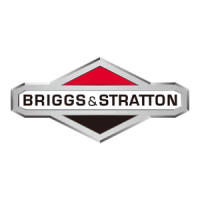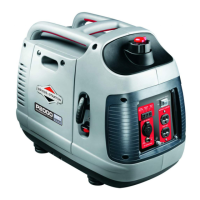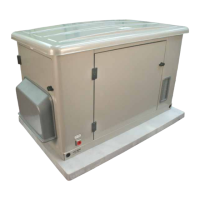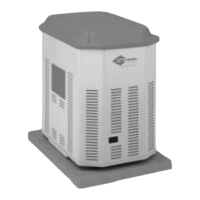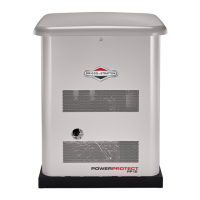15
Charging a Battery
Your generator has the capability of recharging a
discharged 12 Volt automotive or utility style storage
battery.
NOTICE
• Not for use with any other type of battery.
• DO NOT use the unit to charge any 6 Volt
batteries.
• DO NOT use the unit to crank an engine having a
discharged battery.
To recharge 12 Volt batteries, proceed as follows:
1. Make sure QPT switch is in OFF (0) position.
2. If necessary, clean battery posts or terminals.
3. Check fluid level in all battery cells. If necessary,
add ONLY distilled water to cover separators in
battery cells. DO NOT use tap water.
4. If the battery is equipped with vent caps, make
sure they are installed and are tight.
5. Connect battery charge cable clamp with red
handle to battery post or terminal indicated by
Positive, POS or (+).
6. Connect battery charge cable clamp with black
handle to battery post or terminal indicated by
Negative, NEG, or (–).
7. Connect battery charge cable connector plug to
the 12 Volt DC panel receptacle.
8. Start generator as described in Starting The
Engine. Let the engine run while battery
recharges.
NOTICE Normally a period of 30 to 120 minutes is
sufficient to recharge a weak battery.
9. When battery has charged, shut down engine as
described in Stopping The Engine.
10. Remove the battery charging cable from the
generator and then disconnect from the battery
posts.
NOTICE Use an automotive hydrometer to test battery
state of charge and condition. Follow the hydrometer
manufacturer’s instructions carefully. Generally, a battery
is considered to be at 100% state of charge when
specific gravity of its fluid (as measured by hydrometer)
is 1.260 or higher.
WARNING Storage batteries give off explosive
hydrogen gas during recharging.
a long time after battery has been
charged. Slightest spark could ignite hydrogen
causing explosion resulting in death or serious
injury.
Battery electrolyte fluid contains acid and is
extremely caustic. Contact with battery fluid could
cause chemical burns resulting in serious injury.
• DO NOT allow any open flame, spark, heat, or lit
cigarette during and for several minutes after charging a
battery.
• Wear protective goggles, rubber apron, and rubber
gloves.
• DO NOT continue to charge a battery that becomes hot
or is fully charged.
• DO NOT leave battery unattended.

